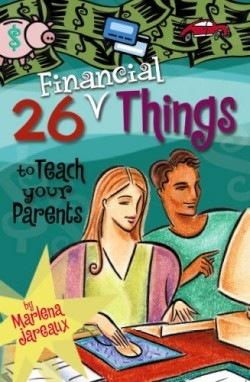
26 Financial Things to Teach Your Parents
Tweens and teens who don’t know much about the important financial decisions and potential pitfalls they will be facing in the coming years will find basic information on budgeting, using checks and credit cards, and other financial information in Marlena Jareaux’s 26 Financial Things to Teach Your Parents.
Despite the title, parents probably won’t learn much they don’t already know from this book, which provides little more than superficial information on monetary matters.
The section on budgeting, for example, suggests that people track all their expenses for at least two weeks (not enough time for someone who has monthly expenses like rent or a cell phone bill), but doesn’t make clear what a person should do with that information or how to make a budget based on what they would like to spend rather than what they have been spending.
The book also gets somewhat repetitive, devoting several tips to the importance of paying bills on time and suggesting in a couple of different places that someone wouldn’t want to pay a bill and then not get the goods or services they paid for, so people should pay their bills. In a book that’s limited to twenty-six tips, the author could have been more selective and thus included more information.
Still, the book provides a decent overview for people who haven’t dealt with financial issues before, such as a teenager getting his or her first job. It covers issues such as how to build credit, how to save money by comparison shopping, how credit cards and savings accounts work, and why it’s better to pay off credit cards immediately or pay in cash for big items.
While the concept of paying yourself first is the second principle noted in the book, there’s no mention of retirement accounts and little about why a person might want to invest in stocks or mutual funds, which certainly would be of importance to parents.
The book also doesn’t offer any tips for talking to your parents about money, which is usually a sticky subject that adults don’t like to share with their kids. So the title of the book doesn’t come through in the text, but it can still provide a good foundation for learning about money to the book’s true target audience: kids between the ages of eleven and seventeen.
Disclosure: This article is not an endorsement, but a review. The publisher of this book provided free copies of the book and paid a small fee to have their book reviewed by a professional reviewer. Foreword Reviews and Clarion Reviews make no guarantee that the publisher will receive a positive review. Foreword Magazine, Inc. is disclosing this in accordance with the Federal Trade Commission’s 16 CFR, Part 255.
